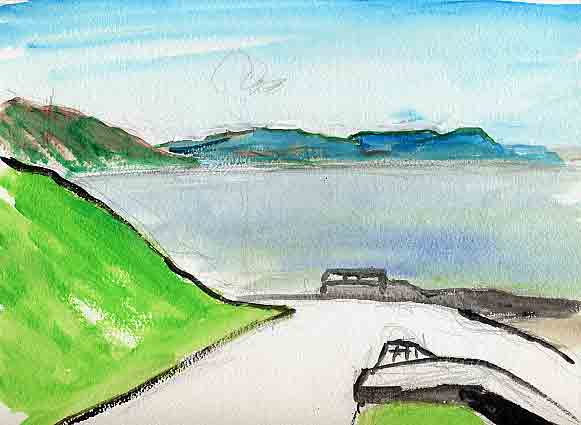|
Long Entry has become a tarmac path, and going on down it—
But wait, what's
the matter with those three gulls on the grassy slope to your left?
They are pattering with both webbed feet, like soldiers very rapidly
marking time. Then each of them moves to another spot and does the
same pattering dance. They know that this action will bring worms
up to the surface!
The path ends on
a sharp cape, which I call Broken Point, above the tide-washed rocks.
The sea has taken, and is still taking, a bite out of the land,
and by 1750 Long Entry had been broken off.

The breaking goes
on. Look at the high corner of the grassy slope behind you, topped
by a fence and bushes: there is what looks like a path steeply down
the actual corner — but it is an erosion gully; its latest cascade
of earth lies at the bottom.
On the parapet are
some interesting signboards, telling you about the nature of the
coast that stretches ahead. The nearest huge mass is called Timber
Hill, or its top is; in the dip beyond it is Charmouth, of which
only one white building pokes into view; then the next hill, Stonebarrow;
the next and most memorable in outline is Golden Cap; and others
fade into the distance.
Down below you,
if it's a low or partly low tide, the beach is almost too fantastic
to describe: a congeries of seaweed and inlets and ripple-crinkled
sand and rock pavements and crowds of errant rocks on which may
perch gulls and a cormorant.
If you're down here
early, you may encounter our friend the crow lady. She'll say “Excuse
me, I'm going to make a horrible noise. 'AAGHKKH!'” Crows come
flying (sometimes they don't deign to come) from the cliffs for
the snack she has for them, and she'll tell you about the admirable
qualities of these intelligent birds. And down on the other, outward-facing
side of the point, there's a tough man who takes a swim no matter
how cold the dawn.
You can double back
around the sides of the cape to left,
or right.
|
